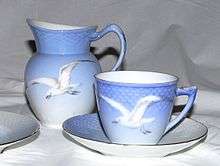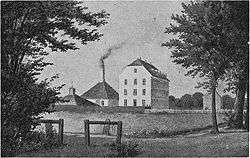Bing & Grøndahl
|
Bing & Grøndahl's first factory, near the Vesterbrogade (1856) | |
| Porcelain manufacturer | |
| Founded | 1853 |
| Headquarters | Copenhagen, Denmark |
| Website | Royal Copenhagen |
Bing & Grøndahl was a Danish porcelain manufacturer founded in 1853 by the sculptor Frederik Vilhelm Grøndahl and merchant brothers Meyer Hermann Bing and Jacob Herman Bing.[1] The trademark backstamp for Bing & Grøndahl (B&G) porcelains is the three towers derived from the Coat of Arms of Copenhagen.[2] The company's Seagull dinnerware series became known as the "National Service of Denmark" in the 1950s when it was found in one tenth of all Danish households. In 1987 the company merged with its primary competitor, the Royal Porcelain Factory under the name Royal Copenhagen.
History
Bing & Grøndahl was founded on April 15, 1853, by Grøndahl, who was a figurine maker for the Royal Danish Porcelain Factory, and the Bing brothers, who were art and book dealers. The factory was located on the corner of Vesterbrogade and Rahbek Allé in the Vesterbro area, at that time outside the city of Copenhagen, Denmark. Grøndahl initially began the company to produce bisque figurines modeled on the neoclassical sculptures of Thorvaldsen. The company extended production to include high style dinnerware and coffee sets.[1]

The company's signature design, Seagull, was created in 1892 by designer Fanny Garde (1855-1925). The modest, classic design features flying seagulls against pale blue backgrounds, sea horse handles and shaded patterns of scales around the edges. Due to its popularity from the 1950s to the 1980s, the Seagull design was considered the "National Service of Denmark". During that period one out of every ten Danish households owned some of the dinnerware service.
In 1895, Bing & Grøndahl created the first in their series of Christmas plates. Designed with a traditional winter scene in cobalt blue and white, the plates have been released annually for more than 100 years. Noted as desirable by collectors, this series became responsible for a large portion of the company's production.
In 1987 the company merged with its primary competitor, the Royal Porcelain Factory under the name Royal Copenhagen.

The tea service designed by Gertrud Vasegaard in 1956 was included in the Danish Culture Canon as a masterpiece of Danish design.[3]
Notes
References
- Engelstoft, Poul Porcelænsfabrikken Bing & Grøndahl 1853-1928 (Poul Engelstoft og J.H. Bing). Ill. Kbh. 1928, 90pp
- Minardi, Robin Hecht, "Scandinavian Art Pottery: Denmark and Sweden", Schiffer Publishing Ltd., Rev. 2nd Ed., 2005, p. 36-46, ISBN 0-7643-2239-7
- Owen, Pat,Story of Bing and Grondahl Christmas Plates, Viking Import House, 1985, ISBN 0-911576-02-9
- Owen, Pat, Bing and Grondahl Christmas Plates: The First Hundred Years, Landfall Press, 1995, 255pp, ISBN 0-913428-76-0
- Pope, Caroline & Nick, Bing & Grondahl figurines, Schiffer, 2002. 248pp
- Smyth, Robert Leslie and R. S. Weightman, The International Ceramic Tableware Industry, Taylor & Francis, 1984, ISBN 0-7099-2352-X
- Zahle, Erik, Bing and Grondahl, 1853-1953, Danish Museum of Decorative Art, 1953
External links
| Wikimedia Commons has media related to Royal Copenhagen. |
- Royal Copenhagen official website
- Bing & Grondahl factory marks 1853 to 2003, The Art of Dating Bing & Grondahl, www.jamiri.dk
